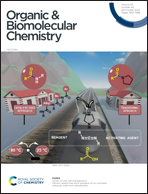Substituent effects of the phenyl ring at different positions from the α-carbon of TEMPO-type nitroxide†
Abstract
Nitroxides are known to undergo oxidation, reduction, and radical scavenging reactions due to their stable radicals. Nitroxides have a wide range of applications due to their reactivities, including radical detecting probes and catalysts. Because nitroxides are easily reduced by ascorbate, a reducing agent, in biological applications, it is critical to control their reactivity to use them as a probe to trace the target reaction. On the other hand, the phenyl group, which is present in many functional organic molecules, is useful for controlling the electronic and steric effects. However, there has been few systematic studies on the substituent effects of TEMPO-type nitroxides with phenyl rings in the vicinity of a radical (α-position). In this study, we synthesized three nitroxides with a phenyl group at the α-position of a TEMPO-type nitroxide and tested their redox properties. The results showed that the reduction reactivity and redox potential differed depending on the position of the phenyl group, implying that the phenyl group one carbon away from the α-carbon of the N–O moiety increases the degree of steric hindrance. This finding is expected to be the basis for the development of functional nitroxides.



 Please wait while we load your content...
Please wait while we load your content...